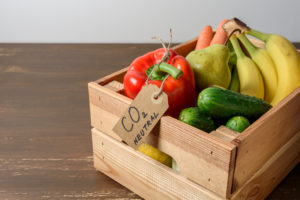Feature: Should food come with a carbon footprint warning?
Many products now come with calorie warnings, but should they also advertise their impact on the environment as well?
Walk down any supermarket aisle and the chances are you will be bombarded with information about all the food and drink on offer.
From sugar content to ethical food standards, like the Red Tractor logo, it seems modern shoppers have never had it so good when it comes to informed choices about what we eat and drink.
But should supermarket food and drink now come with labelling explaining the products carbon footprint? After all, food production – particularly red meat – can be a major source of emissions, and as shoppers look for greener choices, shouldn’t manufacturers be more open about the environmental impact of these items.
Food and drinks manufacturers are certainly promoting more products as ‘carbon neutral’. Only last month, the Co-op announced it will be the first supermarket to sell fully carbon neutral own brand food and drink by 2025.
In an industry-first move, the Co-op said it will price match its plant-based GRO range against equivalent meat products.
It will make its entire 200-strong home delivery fleet electric, end the use of fossil fuel heating, lower farm agricultural emissions, cut packaging and reduce impacts from soy in animal feed.
‘Emissions from our operations and our own-brand products are where we have the greatest responsibility and can make the biggest difference,’ says Co-op Food chief executive, Jo Whitfield.
‘Now when our members buy Co-op branded products and services we give local causes a helping hand and we’ll be addressing the urgent need to tackle the climate crisis. Funding schemes worldwide to tackle carbon emissions and supporting reforestation in the UK.’
However, there is a big difference between simply branding a product as ‘carbon neutral’ and clear labelling about a footprint. There is also the danger that such labelling could get lost in the packaging itself, or that consumers are already bombarded with so many details about a product that it would simply be a case of ‘information overload’.

Then there are the obvious concerns about ‘green washing’. Can food manufacturers be trusted to provide accurate information about the true carbon footprint of a product, or will they use offsetting measures to mask its true environmental cost?
And then there could be the unintended consequences. Everybody knows that red meat produces more carbon than say chicken, but if there is a massive move away from beef to chicken could that mean more intensive farming and lower food standards.
‘I think It is important for consumers to better understand the carbon intensity of what they buy – however, some of the current labels (e.g. by the Carbon Trust) seem of limited value,’ says Eunomia’s head of sustainable business, Mark Hilton.
‘For example, I don’t believe that consumers will understand something that states grams of carbon while something as vague as “carbon measured” or “reducing carbon” is somewhat meaningless and could just be considered greenwash.
‘If this is going to work we believe that it needs to be a simple colour-coded system (perhaps like the A to G energy scale for appliances) – although there is a question over whether this should be relative (e.g. within a product category) or absolute (which would be more useful when comparing across product categories). As implied by the question, perhaps we just need to highlight the very high carbon products with a clear red label for example. Either could be backed up by more detail via a QR code if people want that,’ adds Mr Hilton.
‘There remains the problem of consumer information and label overload – ideally we would rationalise and have an agreed national set that everyone has to use and some that are no longer allowed where considered unhelpful or greenwash.
‘Product carbon footprints are quite involved to do properly and accurately,’ adds Mr Hilton. ‘The important thing is that the method is reasonably comprehensive, focusing on the hotspots across the lifecycle, and is to an agreed standard. This has been the aim of the EU PEF project. While useful, it would be pretty onerous and perhaps unrealistic to expect businesses to provide a standardised carbon footprint for every single product. It is perhaps more realistic to have a more generic carbon footprint for every category / sub-category of product to help inform consumers in broad terms e.g. cotton textile garments are more carbon intensive than polyester ones, rather than to make detailed choices within a category – or as noted above – just a warning where the product is deemed ‘high carbon’ might be a sensible and effective compromise.’
Phill Davies, the co-founder of Magway - a high-capacity low-carbon delivery system believes it is not a ‘matter of if, but when’ products come with a ‘carbon cost’ warning.
‘As consumers become increasingly eco-conscious, they are already expectant of brands to “do the right thing” and inform shoppers of their sustainability practises and environmental impact. It will in time become a serious contender for competitor differentiation, especially amongst the highly sort after and valuable Gen Z and millennial age profiles,’ says Mr Davies.
‘In fact, recent McKinsey research indicates 60 to 80 percent of Gen Zers globally think that brands should be held to account for their actions.
‘With industries such as fashion and fast moving consumer goods (FMCG) under increasing regulatory and consumer pressure to operate sustainably, there will be a natural move towards brands visibly demonstrating their “eco-credentials”.
‘FMCG brands are undergoing a reassessment of the impact of their operations upon the planet. As already popularised by the aviation industry, “carbon miles” will form a fundamental component of these evaluations and can be very practically achieved.
‘Calculating the carbon cost of a product must take into account every aspect of its life up until the moment it is consumed and eventually disposed. An important moment to capture, and one where brands can make a lot of progress, is in lowering the carbon cost of the transportation of a product within the supply chain. Here, turning towards low-carbon, and even zero emission, technologies is key. Our system Magway, for instance, uses electric powered proprietary linear motor and control technology to move goods at high-speed between hubs using magnetic waves. As an alternative to HGVs, Magway drastically reduces CO2 emissions and, when powered by renewables sources, can even be a net-zero contributor of emissions.’
But Stacey Skidmore, managing director of sustainable retailer, Ecovibe, says many consumers are still unaware of the environmental impacts of their product choices.
‘The carbon footprint of many of our everyday products, especially those which have been imported, is shockingly high, with a huge 5.5kg of carbon produced to make just one polyester shirt,’ she tells Air Quality News.
‘It’s the law to disclose the number of calories within food and drink products sold in stores, which has proven an effective way to drive more health-conscious choices. Likewise, displaying vegan and cruelty free on cosmetics products has had a similar impact to alter mindsets, so it’s time something similar is used for environmental impacts.
‘It could prove hugely beneficial to label products with the amount of carbon used to manufacture them. However, this calculation can become very complex from the raw materials used, manufacturing process, to delivery of the goods. To allow consumers to make accurate comparisons, the “carbon cost” calculation would require a consistent approach throughout.
‘By providing this clarity, it will increase the understanding of the environmental impacts of many everyday products and help to encourage consumers to make more sustainable and environmentally friendly choices,’ adds Ms Skidmore.
Today’s shoppers are definitely becoming more environmentally aware and will want to see food manufacturers and retailers follow suit. Whether full-on carbon labelling becomes the next big thing is a moot point, but carbon neutral ranges are definitely here to stay.
This article first appeared in the June Air Quality News Magazine, which is available to view here.















